Toasted anchovies and sesame seeds coated in a honey-soy sauce glaze, Tazukuri is a sweet and savory snack served in the Osechi Ryori menu of traditional Japanese New Year foods. You can also enjoy these candied anchovies with a cold beer anytime of the year!
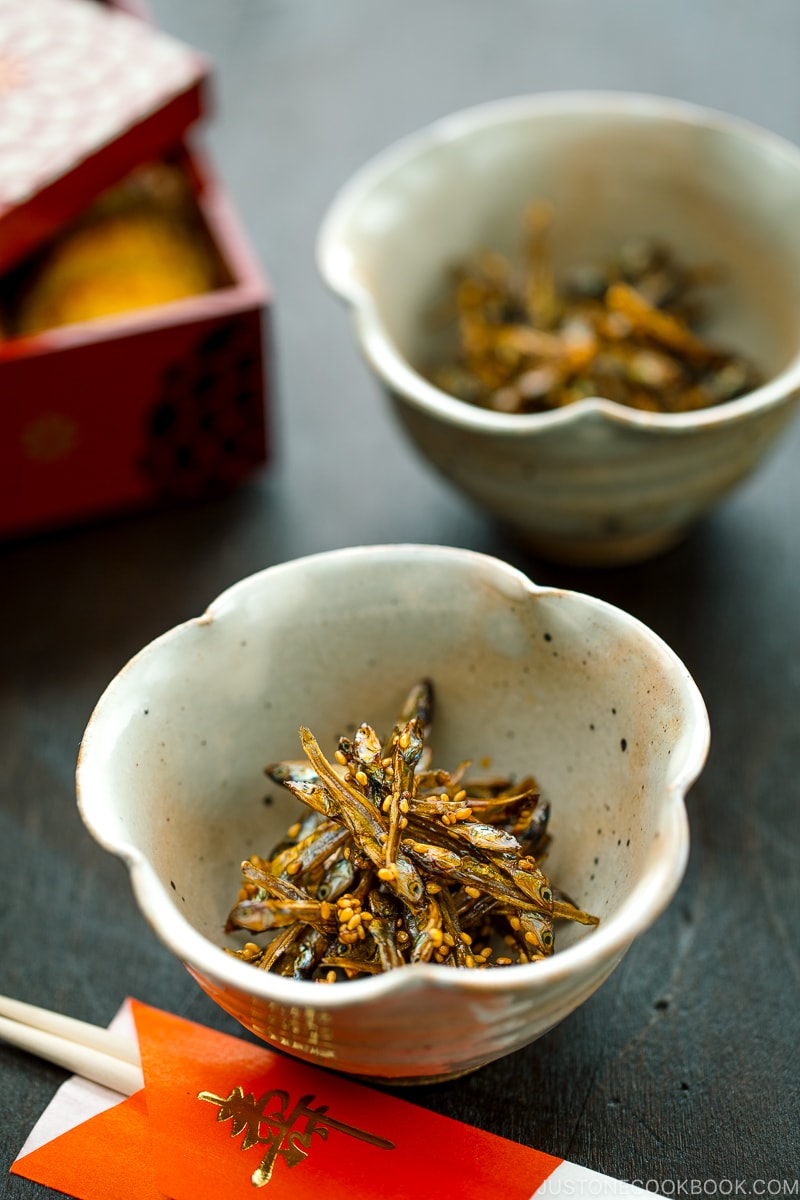
To kick off my Osechi Ryori Recipe Series (おせち料理), I’d like to start with a classic dish called Tazukuri (田作り) or candied anchovies. These anchovies are crunchy, sweet, and deeply savory, which make them a fantastic snack to enjoy along with the other delicacies served as part of the Japanese New Year’s foods.
If you love munching on little bites with cold beer or sake on New Year’s Day, you will love tazukuri! What more? They are ridiculously easy to make and ready in 10 minutes!
Tazukuri – Well-Meaning & Savory Bites for Osechi Ryori
Tazukuri (田作り) is a very popular dish for osechi ryori and it is made of roasted Japanese anchovies coated in a sweet soy sauce glaze. Cooked in low heat over a frying pan with sesame seeds, these anchovies are then tossed in sake, soy sauce, sugar, and honey until caramelized and crispy.
Japanese anchovies play an important role in Japanese cuisine. We eat tazukuri on New Year’s Day as they symbolize a bountiful harvest. Tazukuri (田作り) literally translates as “making (作り) rice paddy (田)” as anchovies were once used as fertilizers for rice fields.
Because Japanese anchovies are known as a great source of calcium, my mom always made sure I had eaten tazukuri on New Year as they are good for strong bones. Now it’s my turn to make sure my children eat this dish for strong bones.
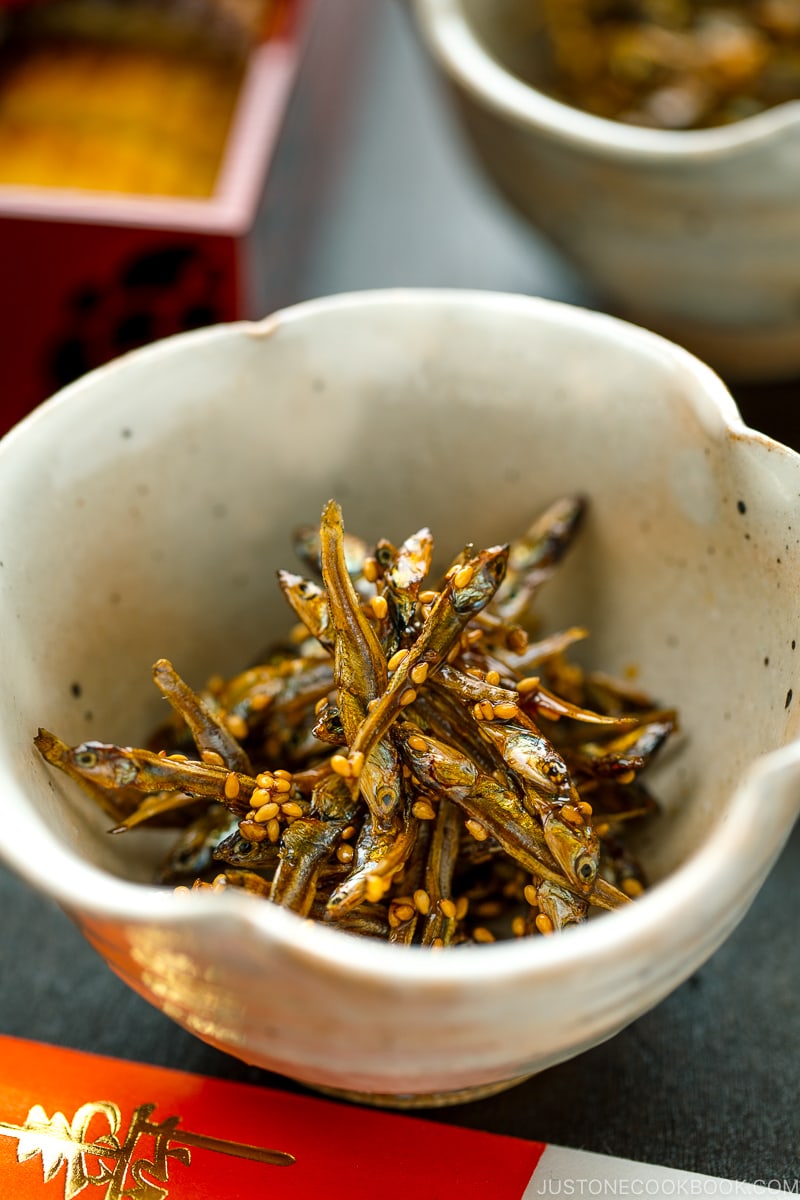
Ingredients You’ll Need
- Dried Japanese anchovies (Tazukuri or Iriko/Niboshi)
- Toasted white sesame seeds
- Seasonings: sake, soy sauce, sugar, and honey
I used only sesame seeds for my tazukuri, but you can also add silver almonds or crushed walnuts to the mix.
Different Types of Dried Anchovies
For this recipe, we use a specific type of dried Japanese anchovies called tazukuri—yes, the same name as the dish. Tazukuri is simply rinsed in water and dried, without boiling in salt water like regular anchovies. Therefore, the “tazukuri” anchovies are not salty compared to the regular ones. They are also flat and straight.
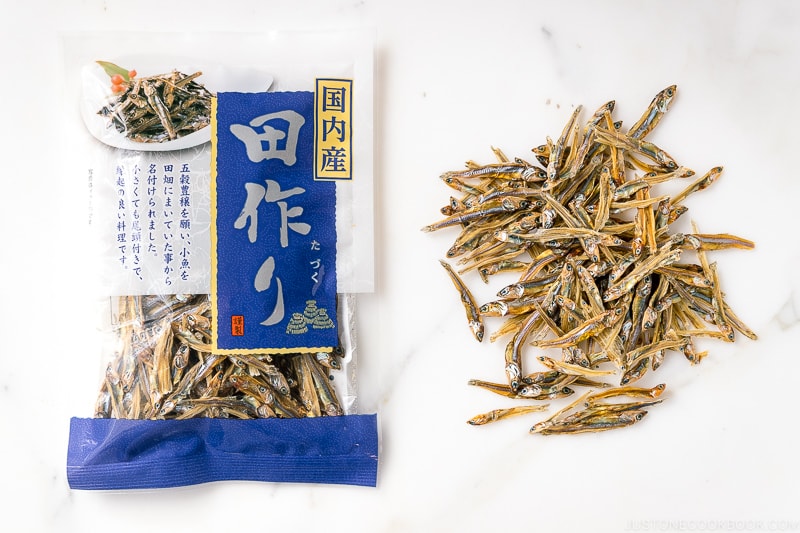
You can find tazukuri at Japanese grocery stores only in December, just around the time when people start preparing for the Japanese New Year celebration. Unfortunately, since this is a very specific ingredient that’s used for the Japanese New Year, you will most likely not find them in Asian grocery stores.
You can definitely use regular dried anchovies. They are called iriko (いりこ) in the Osaka region and niboshi (煮干) in the Tokyo region. Unlike tazukuri, they have been boiled in salt water and then dried, so iriko/niboshi are slightly saltier.
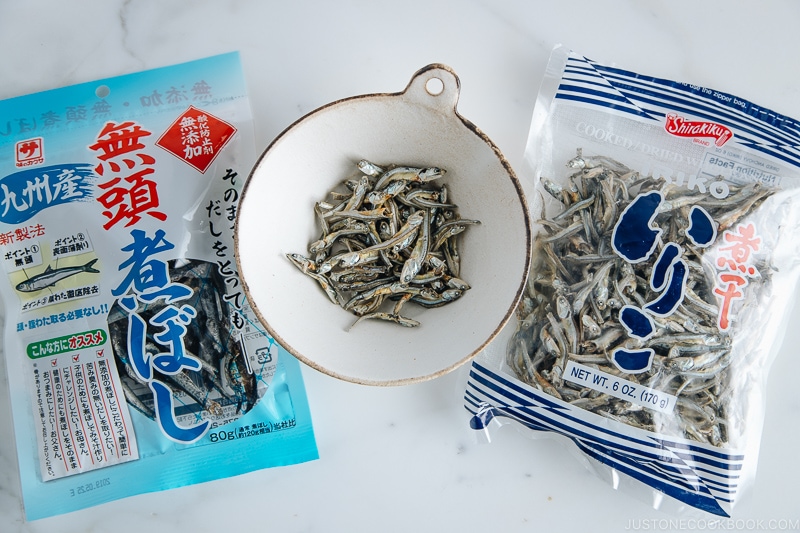
Iriko or niboshi are often used in making dashi soup stock or eaten whole as a snack. The bold, savory taste is unbeatable. They are also very popular in Korean and Southeast Asian cuisine.
👉🏻 You can read more about iriko/niboshi on my pantry page.
Where to buy dried anchovies: You can find iriko/niboshi sold in plastic bags in most Japanese and Asian grocery stores. Both the Japanese and Korean baby anchovies are interchangeable.
Make Ahead Recipes for Osechi Ryori
There are a variety of dishes that go into making the New Year’s feast, so I like to make a list for the ones that I can make ahead. Tazukuri is often one of the first items I prepare early since they store well in the refrigerator for 7-10 days.
For those of you who would like to adopt Japanese New Year traditions, I definitely recommend making these candied anchovies for your osechi ryori!
More traditional osechi dishes you can easily make ahead:
- Instant Pot Kuromame (Sweet Black Soybeans)
- Kuri Kinton (Candied Chestnuts and Sweet Potatoes)
- Datemaki (Sweet Omelet with Fish Cake)
- Kobu Maki (Salmon Kombu Roll)
❤️ Learn more about Japanese New Year’s traditions and browse our complete osechi ryori menu.
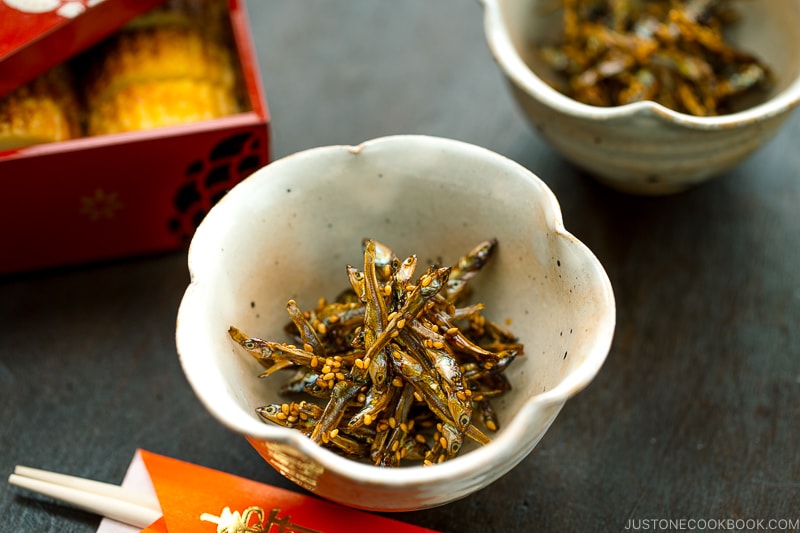
Wish to learn more about Japanese cooking? Sign up for our free newsletter to receive cooking tips & recipe updates! And stay in touch with me on Facebook, Pinterest, YouTube, and Instagram.
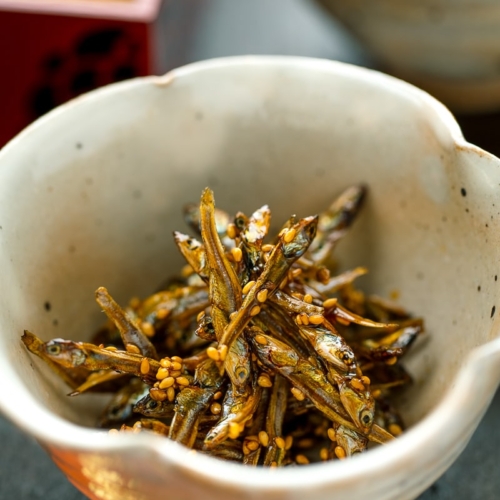
Tazukuri (Candied Anchovies)
Video
Ingredients
- 1 cup tazukuri (dried anchovies) (tazukuri is only available in December at Japanese markets; you could use iriko or niboshi (boiled and dried anchovies), but they will be slightly saltier since they are boiled in salt water before drying)
- 1 Tbsp toasted white sesame seeds
- 2 Tbsp sake
- 1 Tbsp sugar
- 1 Tbsp soy sauce
- 1 Tbsp honey
- ⅛ tsp neutral oil (optional, but it helps to separate the anchovies once cooled)
- 1 red chili pepper (optional; leave whole and add it to the simmering sauce for a spicy kick)
Instructions
- Before You Start: If you will include this dish in your Osechi meal, I recommend cooking it up to 4 days before you plan to serve. For more helpful tips on planning your Japanese New Year feast, please read my A 5-Day Osechi Cooking Timeline blog post.
- Gather all the ingredients. Prepare a baking sheet lined with parchment paper.

- In a dry frying pan (no oil), toast 1 cup tazukuri (dried anchovies) on medium-low heat for 5–10 minutes or until crispy.

- Next, add 1 Tbsp toasted white sesame seeds to the frying pan and toast for 2 minutes. Shake the pan constantly so the sesame seeds don’t burn. When you can break an anchovy into two pieces with your fingers, transfer the anchovies and sesame seeds to the lined baking sheet.

- To the same frying pan, add 2 Tbsp sake, 1 Tbsp soy sauce, and 1 Tbsp sugar. Give a quick stir.

- Next, add 1 Tbsp honey and ⅛ tsp neutral oil. Add the optional 1 red chili pepper to the pan now, if using.

- Bring it to a simmer on medium-low heat. Then, reduce the sauce until it thickens and you can draw a line through the sauce on the pan‘s surface with a silicone spatula.

- Add the anchovies and sesame seeds back to the pan and coat well with the sauce. Once the anchovies are nicely coated with the sauce, transfer them back to the lined baking sheet. Spread the anchovies to let cool.

To Serve
- Once cooled, serve at room temperature to enjoy.

To Store
- You can keep the leftovers in an airtight container and store in the refrigerator for 7–10 days.
Nutrition
Editor’s Note: The post was originally published on December 21, 2013. It’s been republished in December 2021.
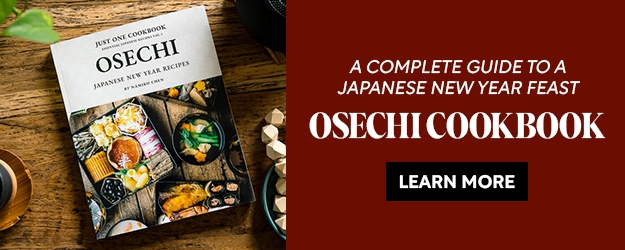
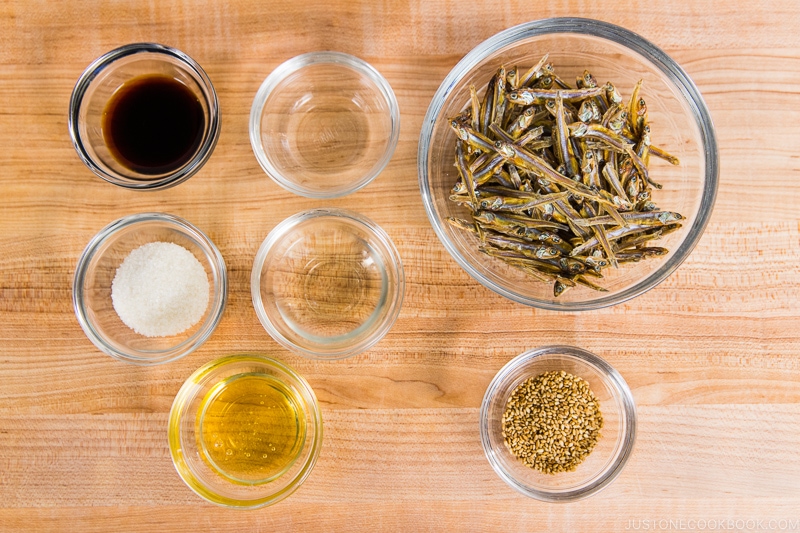

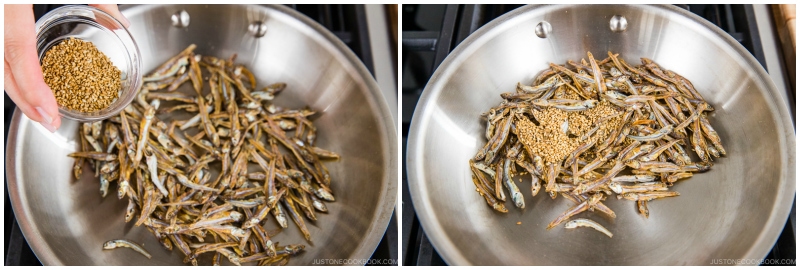
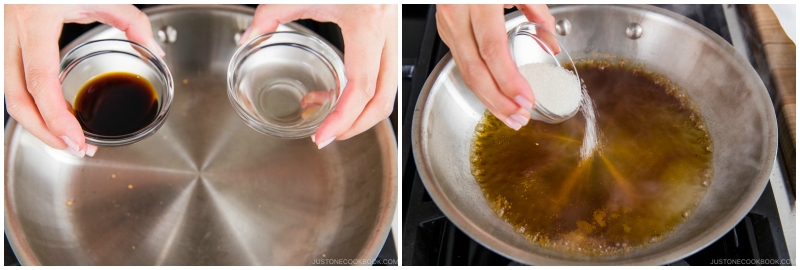
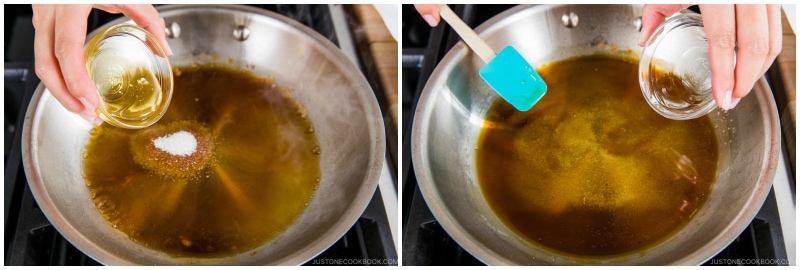
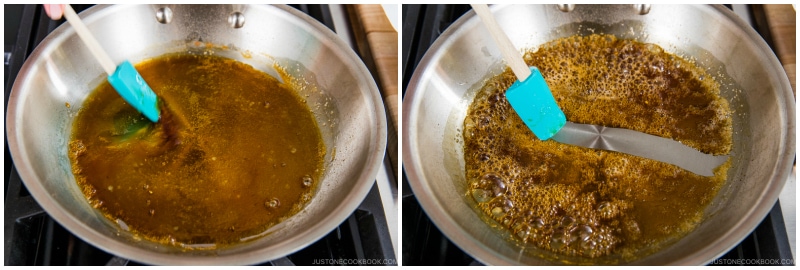
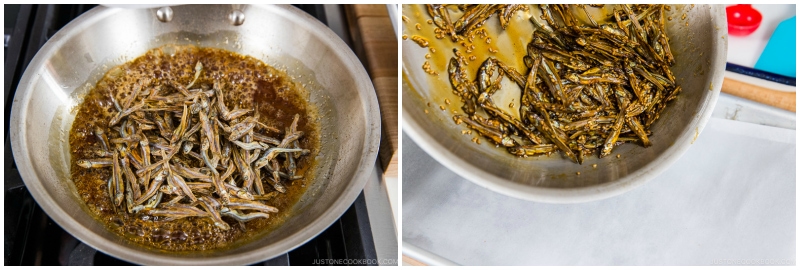
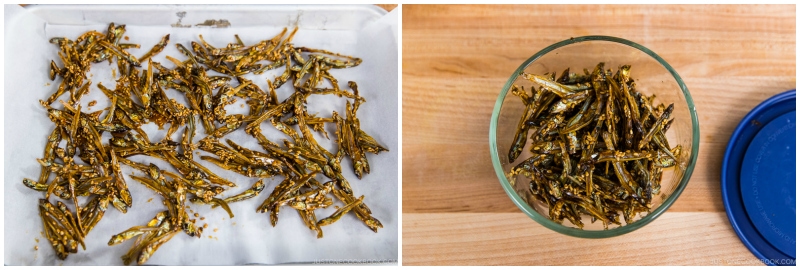











This was awesome just like Mom’s. She’s Okinawan.
Hi Judy! Aww. We are glad to hear you enjoyed the flavor!
Thank you so much for trying Nami’s recipe and for your kind feedback.🤗
I cooked it till the fish was crispy but not burnt. However, how do I add a chewiness to it? It’s only crunchy and when it’s under cooked it’s hard. Do you know if agar agar will lend to a more chewy texture?
Hi, Richard! Thank you for trying Nami’s recipe.
Did you cool the dish after following Nami’s recipe? It will turn chewy once the candy is covered.
We’ve never used agar agar before, and we’re not sure what the results will be.
Hi Nami, how should I add this to your Chex mix recipe? Just add it after the Chex mix is completely finished baking or include it before baking the Chex mix? Thanks. Happy New Year to your family and entire team at JOC
Hello there, Karen! Thank you for spending time reading Nami’s post!
This candied tazukuri will be a little sticky. We haven’t tried it in the Chex mix recipe yet, and we’re not sure how it will turn out, but if we do, we may add tazukuri without coating to the Chex mix recipe at the beginning and mix it with Chex mix syrup.
If you try it, please let us know how it goes!
Hi may i know what type of soy sauce and honey should i use to get the right taste?
Hi Jess! Thank you very much for reading Nami’s post and trying her recipe!
Nami used organic soy sauce from Kikkoman – Koikuchi Shoyu (Dark Colored Soy Sauce) 濃口醤油 and local honey. Any Japanese soy sauce works.😉
https://www.justonecookbook.com/soy-sauce/
We hope this helps!